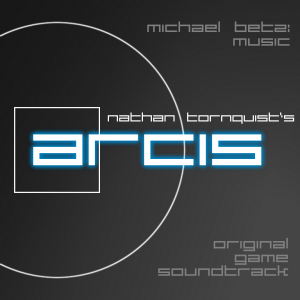I recently completed the music and sound effects for Arcis, Nathan Tornquist‘s latest release, a tower defense game that combines traditional tower defense gameplay with a more involved arcade playing style.
This is not my first collaboration with Nathan. When we were in the 6th grade, we both got the book Game Programming for Teens by Maneesh Sethi and began programming in Blitz Basic. We formed Xenex Games, with the intention of releasing several titles. Soon, however, I became far more interested in composing music than in programming, so our little company disbanded. Our 8th grade year, I wrote the music for Nathan’s Rollout, which amounted to nothing more than a brief MP3 rendering of Finale’s MIDI output. [For more info on the beginnings of our collaboration, check out his blog.] Five years later, Arcis is the next game I have written music for, and this time I also produced all of the sound effects.
Nathan wanted the graphical style of Arcis to evoke 8-bit games without actually being 8-bit. As such, it was my mission to create music evocative of 8-bit music that wasn’t actually 8-bit. I produced all of the audio for this game in FL Studio 10. I began using FL Studio in 7th grade with version 6. While many people deride the DAW for its ease of use (many sub-par tracks are put out by beginning producers), my 7 years of experience have led me to draw the conclusion that FL Studio is a highly versatile DAW that can be used for most applications. I have used it to produce not only electronic music but also orchestral mock-ups and multichannel audio soundscapes.
My original plan for the music was the following:
- Menu Music – Theme 1 played on sparse plucked square synth with delay. – c. 30 sec
- Arcis Suite:
- Theme 1 – c. 2 min
- Theme 2 – c. 2 min
- Theme 3 – c. 2 min
- Arcis Suite Hardcore Version:
- Theme 1 – c. 2 min
- Theme 2 – c. 2 min
- Theme 3 – c. 2 min
- Pause Music – Theme 2 played on sparse plucked square synth with delay. – c. 30 sec
- Game Over Music – Theme 3 played on sparse plucked square synth with delay. – c. 30 sec
My intent was for the audio engine to switch between the normal and hardcore versions in response to difficulty (lots of enemies on screen, low player health, etc.). Initially, it would take approximately 20 minutes to get to the point where it was no longer possible to survive, so I figured a main music loop of about 6 minutes would be the right length to eliminate mind-numbing repetitiveness. However, after some scaling of numbers by Nathan, the average game ended up taking less than 10 minutes. This, combined with the fact that a nearly 15-minute soundtrack would be massive for an app even at 128kbps, made me decide to have only one theme in both normal and hardcore versions. I kept the same idea for the menu/pause/game over music, but once again used the main theme.
The hardcore version of the main theme is exactly the same as the normal version in every aspect but instrumentation. This was so that the two could easily be crossfaded between, resulting in a perceived intensifying of the sound:
The way the game turned out, it didn’t get difficult until around level 40, so we ended up not using the dynamic crossfading. The form of the main theme in its original standalone form (as it appears on the soundtrack) is A A’ B [A A’]’. The music in the game context had to loop, so I added another B section to the end, making the form A A’ B [A A’]’ B.
I used the VST plugin 3xOsc (a basic 3-oscillator subtractive synth) for every synthesizer in the soundtrack. I kept it simple so that the music would be reminiscent of 8-bit music. I did use samples for drums, however. I also wanted to synthesize every sound effect, so once again I used 3xOsc.
With the soundtrack decreasing from a projected length of 13.5 minutes to not quite 5 minutes, I figured that I should create a bonus track of some sort. Not only would this boost the album length, but it would also give people extra incentive to download it. I decided to make a remix of the main theme using only the sound effects for the game. I allowed myself to use pitches other than the originals, to time stretch, to tweak EQ, and to add simple effects like reverb, but in the end all of the samples still had to be recognizable. I also wanted to use every sound effect present in the game. All of the rest of the audio was completed nearly two weeks ago; I started the bonus track yesterday and completed it this morning. Although the bonus track is almost twice as long as the other instances of the main theme, it took me half as much time to create: 5 hours vs. 10. I estimate that I spent approximately 30 hours on music creation and 10 on the sound effects, which turned out to be far more difficult than I had anticipated. Creating sounds that “feel” good as responses to user actions and do not get annoying with constant repetition is challenging.
I find video game audio to be a very enjoyable area of work, as it incorporates composition, production, sound design, and repeated testing of everything. Video games have a lot of potential as an art form, as they directly involve the player in the artistic experience. I hope to keep working on video games as they continue to become more innovative and gain legitimacy in the public eye as an art form.

